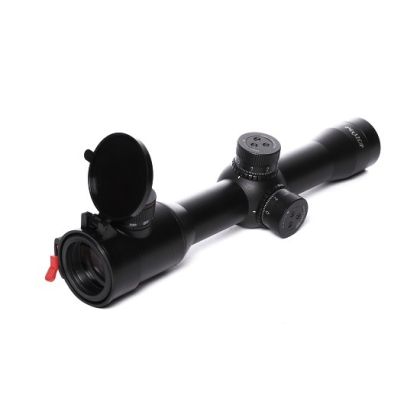Mounts
Hunting Rifle Scopes
Sub Categories
Hunting riflescopes are the most common type of riflescopes. For this reason, this is the biggest category on our website. Even though there are many types of hunting-riflescopes, there are some characteristics that many of them share.

Mounting solutions - Ring and Rail mounts
Both ring and rail mounting options are available. This is the only category where rail mounting is available, but it is only available with some middle-class and premium scopes. There are four rail mounting standards altogether (the rail option offered depends on the manufacturer):
-
LM rail (optical devices with this rail are no longer manufactured but mounts for it are still produced)

Schmidt & Bender Polar T96 2.5-10x50 with a S & B Convex rail
Tube diameter
Tube diameters of 30 mm and 25.4 mm are the most common.
-
Scopes with a 34mm tube are rare – Schmidt & Bender Polar T96 series is one of the few that use it.
-
Zeiss Victory V8 and Blaser Infinity are equipped with a 36mm tube,
-
whilst Swarovski dS is equipped with a tube that measures 40 mm in diameter.
It is important to note that tube diameter does not affect the light transmission rate.
Turrets
Riflescope for hunters is equipped with low-profile, capped elevation and windage turrets. After a scope is zeroed (at 100 m), most users won't make any further adjustments to the windage and elevation. For this reason, the turrets are capped to prevent unwanted rotation.
-
As such optics is commonly used in forests where one can quickly bump the riflescope somewhere, capped turrets are the best way to avoid the unintentional shifts of the point of impact.
-
Furthermore, these are among the most delicate parts and can break if hit too hard.
-
Caps are used to prevent that.
-
With some modern, premium optics, there is an option of purchasing an uncapped, BDC elevation turret which allows the user to quickly compensate for the bullet drop at longer distances by setting the turret to the number for the corresponding distance (1 – 100 m, 2 – 200 m, 3 – 300 m, etc.)
The reticle
Most riflescopes are equipped with a hunting-oriented reticle. Usually, the reticle is a crosshair with thicker lines at the sides and narrower lines towards the center.
-
There are no holdovers or hash marks because it is meant to be simple to use.
-
The reticle is mainly in the second focal plane, meaning that it appears to be of the same size regardless of the magnification, providing minimal coverage of the target.
-
Blaser Infinity with first focal plane reticle configuration is an exception to the rule.
FFP-hunting optics were used in the past but are gradually dying out. Commonly, the riflescope is equipped with an illuminated central dot, the intensity of which depends on its purpose.
Magnification
The magnification is either
-
fixed or
-
variable.
A few decades ago, fixed magnification optical devices were the prevalent type, now it is the other way around. In England, Scotland, South Africa, and some other countries, many users still prefer the fixed type over the variable type. Entry and middle-class riflescopes have a 4–6x zoom factor, whereas the premium ones boast a 6–8x zoom factor.
Parallax
-
Parallax is typically fixed at 100 m.
-
If magnification is above 12x, a riflescope is usually equipped with an adjustable parallax setting (side focus).

Swarovski Z8i 2.3-18x56 has an adjustable parallax turret (on the left)
Subcategories
There are many subcategories:
Best Hunting-riflescopes
Riflescopes of the highest quality are produced by the renowned European sport optics manufacturers such as:
Such devices are equipped with:
-
an illuminated reticle,
-
commonly a fine, central illuminated dot.
The zoom factor is 6x or greater. There is an option of purchasing an uncapped BDC turret on most. Reticles are in the second focal plane, except with the Blaser Infinity series which features an FFP-configuration.
Premium optics boast:
-
an exceptional field of view,
-
impressive resolution,
-
a high light transmission rate, and
-
a high degree of colour fidelity.
They are difficult to compare because there are only small differences among them, but each series has its own strong point (Leica Magnus series, for example, is known for its incredibly wide field of view).
-
The middle-class devices are not to be overlooked since its popularity has risen considerably in the last few years.
-
Most of these devices are made in Japan and highly popular because of their excellent price to performance ratio.
-
Some European-made devices can also be found in this class.
A short presentation is available here.
Video presentations
Short Presentation | HuntingRiflescopes | Optics Trade from Optics-Trade
Filters
Sort
Filters
Sort















































